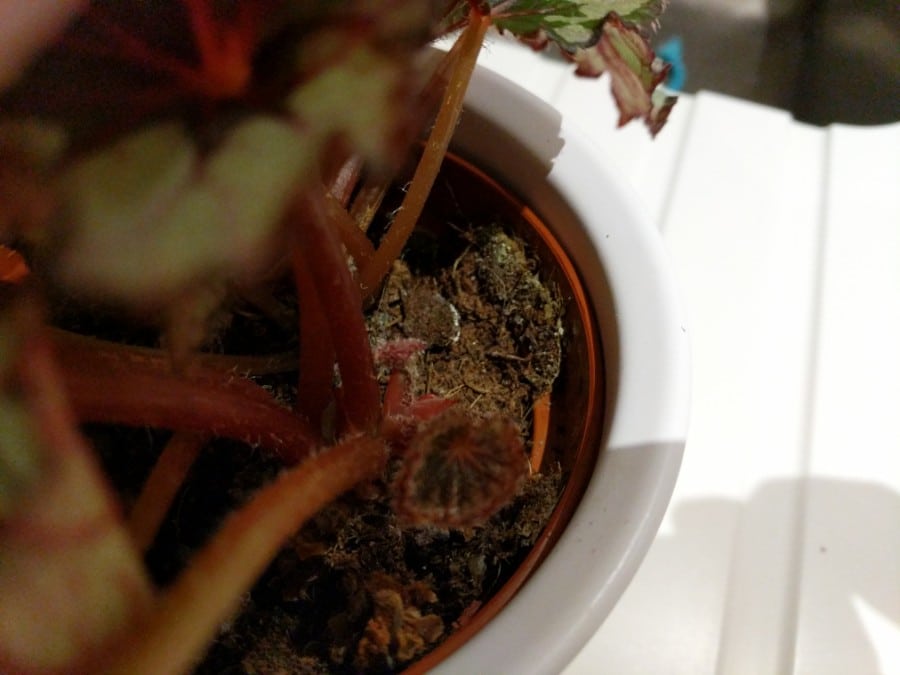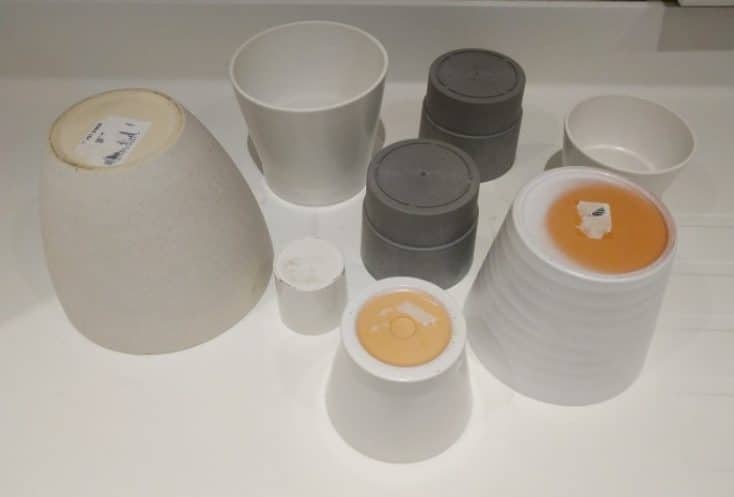Container gardening — growing plants in pots — is an attractive alternative to traditional gardening that is rapidly becoming popular. A common mistake frequently made when container gardening is trying to grow plants in pots without drainage holes.
Can you grow plants in pots without holes? It is possible, but results in too much water in the soil, creating adverse growing conditions. You must provide plants with sufficient moisture without waterlogging the root system. Using pots without holes traps surplus water preventing it from draining out of the soil, which harms the plant.
Not allowing excess water to drain out of the soil, is as critical if not
Why Is Too Much Water Dangerous?
Water. It seems like such a simple thing, really. Plus plants need it to grow, right? So how can too much water be dangerous for plants?
It’s true, plants do need water for the basic biological processes occurring at the cellular level. These processes result in plant growth, the desired outcome of gardening. In this case, though, too much water isn’t a good thing.
To get a better understanding of why proper drainage is so important when container gardening, it’s helpful to first explain soil structure and pore space. Awareness of those concepts makes it easier to comprehend the dangers of excess water in the soil.
Understanding Soil Structure And Pore Space
Soil structure is how solid particles such as sand, silt, and clay are spatially arranged within naturally occurring soils — in potting soil, the structure is the spatial arrangement created between the ingredients combined together in the mix. In both situations, the structure is how the solid particles clump, bind together, and aggregate, resulting in both air and water movement through the soil.
When soil particles arrange together, voids are created between them relative to the size of particles and their alignment. Pore space is the amount of voids — or empty space between soil particles — occurring because of the soil structure. This empty space fills with air and water, as well as plant roots, and beneficial soil microorganisms.
Too much water in the soil pushes air out of the pore spaces, saturating the soil and waterlogging the plant roots. When pore spaces are completely filled with water instead of oxygen problematic conditions are created.
Problems With Waterlogged Soils
Filling the available pore space completely with water creates conditions within the root zone where there is no oxygen available for the roots. This is unhealthy for plants and severely hinders growth, if not completely killing plants.
Waterlogged Soil Suffocates The Roots
Plants need oxygen for many different cellular functions and processes. For processes that occur in the roots, they get the oxygen needed from the air in the soil pore space; the oxygen needed in the leaves is diffused through small air holes in leaf tissue called stomata.
A drawback for plants is that unlike the human body, oxygen is not circulated throughout the plant tissues. Oxygen needed within the roots must come from the soil directly into the cells. It can’t be moved from the leaves.
When soils become waterlogged, the lack of free oxygen in the pores creates what is known as an anaerobic environment. Roots that can’t access oxygen cannot complete the processes needed for growth; respiration being the most important and nutrient uptake following closely behind.
In essence when there is too much water in the soil the plant’s roots drown and/or starve, a situation easy to create in pots without holes.
Waterlogged Soil Causes Root Rot
Root rot is caused when roots die back due to lack of oxygen or the overgrowth of soil fungus. Soggy soils encourage the growth and multiplication of Pythium, Phytophthora, Rhizoctonia, or Fusarium fungi which spreads into the roots, infecting plants. Healthy roots begin to turn brown and mushy as they perish, unable to take in nutrients needed for growth.
The challenge with root rot is that it often goes unnoticed because it occurs beneath the soil surface and out of sight. Once symptoms are visible in the foliage — showing as wilting or yellowing leaves — the problem may be past the point of rectifying, putting the entire plant in danger.
In extreme cases when conditions are perfect, i.e. in pots without drainage holes, root rot can kill the whole plant within ten days.
Pots Without Holes Cause Salt Build Up In The Soil
Synthetic fertilizers are made up of mineral salts; some tap waters also contain soluble salts such as calcium, magnesium, and sodium. Over time, as water evaporates out of the soil or is taken in by plants the salts from watering and fertilizing are left behind in the soil and gradually increase in amounts.
When these salts are allowed to accumulate over time problems arise in one of two distinct ways.
At high concentrations, certain salts such as sodium and chloride are toxic to plants. Sodium is absorbed easily by the plant, and once inside the cells it halts metabolic functions, stopping growth. Once inside the plant chloride is transported to the leaf tissue where it causes marginal leaf scorch. When concentrations of either sodium or chloride reach high enough levels the plant begins to die.
A high salt level in the soil also prevents water and nutrients from moving into the roots or may even pull water out of the plant through a process called osmosis.
Salt is hydrophilic, attracting water and holding onto it tightly making it difficult for plants to “pull” water from the soil and take it into the roots. When the salt concentration is higher in the soil than inside the roots, since cell walls are semi-permeable, osmosis moves water from inside the plant to the soil in an attempt to balance the concentrations.
In conditions where water can move downward through the soil, these excess salts are leached out of the container. Or the soil can be “flushed” with clean water to push them out. Pots without holes in the bottom don’t allow the salts to move out of the soil.
How To Prevent Overwatering
In any type of gardening, regardless of the methods used, overwatering is one of the most common problems affecting plans.
Learning to water appropriately depends on many factors including the individual plant and the environmental conditions surrounding it. Heeding the following tips can aid in preventing overwatering, and keeping plants healthy
Water When The Soil Is Dry
It sounds strange in a way to even mention something so simple but it is the best tip available.
Many people water plants without checking the soil moisture levels; they water them on a schedule (or when they remember to do so) versus watering them when they really need the moisture. This not only wastes water but endangers the plants as well.
Before watering plants, stick a finger in the soil to see how much of the soil is still wet. Allow the top 1-2 inches of soil to dry out thoroughly before giving the plant water again.
Provide Proper Light And Ventilation Conditions For The Plant Type
Optimal light conditions drive photosynthesis, encouraging plants to pull water from the soil to fuel the process. Adequate air movement, when coupled with good lighting, draws moisture out of the leaves through evapotranspiration and the soil through evaporation. This cycle of natural water loss reduces the chances of soils becoming waterlogged.
Skip Creating A Drainage Layer In The Bottom Of The Pot
For a long time, this was a highly recommended practice, taught to new gardeners. It’s been proven though that this practice is more detrimental than helpful
As water moves down through the soil profile via gravity, it stops when it encounters this drainage layer created by rocks or small stones. Before the water percolates into the layer, the entire potting soil must fill with water rendering the layer problematic instead of beneficial.
Create A Cachepot If You Want To Grow Plants In Pots Without Holes

At times it’s necessary to grow plants in pots without holes for one reason or another. In this case pot the plant in a well-draining container just slightly smaller in diameter than the non-draining container. Then place the smaller container inside the larger one, setting it on something that creates a small space between the two bottoms allowing the smaller container to drain into the larger one.
Related Questions
Can drainage holes be added to pots that don’t have them?
- Depending on the type of pot, drainage holes can be drilled in the bottom of pots using a cordless power drill. Plastic and metal containers are more suited for adding drainage holes; terra cotta or clay pots may crack unless a special masonry drill bit is used.
If plants are overwatered, is it possible to fix the problem?
- The best way to correct overwatering is to repot the plant into a different pot if feasible. During the repotting process gently remove some of the waterlogged soil from the root ball, replenishing it with fresh, new soil.

